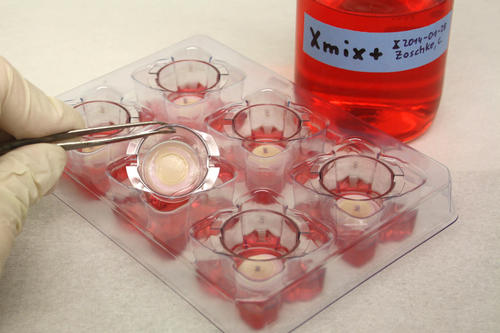Skin Cancer from a Lab
Doctoral Candidate Christian Zoschke Works on a Tissue Model for Drug Tests
Sep 02, 2014
The researchers use skin cells to grow skin models that can be used to test new cancer-fighting active ingredients and other drugs.
Image Credit: Christian Zoschke
To Christian Zoschke, being able to do some small part to help both people and animals is good reason to sit in the lab every day, even in fantastic summer weather. Besides that, the 26-year-old doctoral candidate deals daily with the dangerous consequences of getting too much sunshine: As part of his doctoral project at the Institute of Pharmacy at Freie Universität Berlin, he is working on growing skin cancer in the lab.
Zoschke’s goal is to develop a model that can be used to test active ingredients to fight the life-threatening disease, and one that is so true to life that animal testing is not necessary. The current practice is for researchers to expose “nude” mice (a hairless strain of lab mice) to strong UV radiation in order to trigger skin cancer in the animals and then use them to test the efficacy of cancer drugs. Zoschke is developing a model of a form of skin cancer known as cutaneous squamous-cell carcinoma, which is supposed to be used as the basis for drug testing.
There are an estimated 150,000 new cases of this type of cancer in Germany every year. The beauty ideal of tanned skin is one reason for the disease’s increased prevalence. Diagnosing this form of cancer is not easy, and even with successful initial treatment, it usually recurs. The lab-scale cancer model is based on pieces of skin about two square centimeters in size that are left over after surgeries.
Zoschke uses enzymes to first break down these pieces of skin into their various layers before isolating individual cells from them. The doctoral candidate and his team then propagate these skin cells and form special cell “constructs” from them. These consist of healthy cells from the epidermis (keratinocytes) and dermis (fibroblasts) and malignant cells taken from tumors removed from patients. “We call this an ‘organ-like’ culture, with every construct measuring about two centimeters in diameter,” Zoschke explains.
“A form of cancer like squamous-cell carcinoma, which takes decades to develop in a human patient, forms in just a few weeks in the lab,” Zoschke says. This is due to the fact that the models are cultivated under optimum conditions, meaning that they are kept in incubators at body temperature, with a complex growth medium added. A cross-section magnified several times over under a microscope lets the researchers see the results on a computer screen.
Zoschke is doing his doctoral work in Monika Schäfer-Korting’s research group. Schäfer-Korting, a professor of pharmacology at Freie Universität Berlin, is researching the development of alternatives to animal testing (see Tagesspiegel interview, in German). She and her team have been successfully working to replicate human skin in a lab setting for years, using the results as a model for various diseases, such as infections and genetically determined skin conditions. Zoschke’s model is the first of its kind for cutaneous squamous-cell carcinoma. Right now he is working to optimize the model, using various methods to show that his tumor model is very similar to the situation with naturally occurring cancer in human patients, and moreover, how test substances work in this model. “The combination of the various biotechnology methods used here is new and unique,” Zoschke says.
And yet, there is one problem the junior scientist has not yet solved in his work. “It is still an isolated model that is not connected to any living organism,” he admits. “That means we can’t yet make any statements about the consequences that an active ingredient that is undergoing testing will have on the human body overall.” A drug could travel to other organs if the squamous-cell carcinoma is treated locally, even in small amounts, Zoschke says.
Still, he points out, there is already a research group at Technische Universität Berlin that is recreating multiple organs in miniature form and connecting them through a kind of circulatory system. Another group, this one at Freie Universität Berlin and Charité – Universitätsmedizin Berlin, is using computer models to work on predictions of how drugs spread through the body and are metabolized, the researcher reports. According to Zoschke, “The combination of these approaches seems very promising in terms of reducing the animal testing that is still necessary today.”
Further Information
- Christian Zoschke, Institute of Pharmacy, Freie Universität Berlin, Email: christian.zoschke@fu-berlin.de

